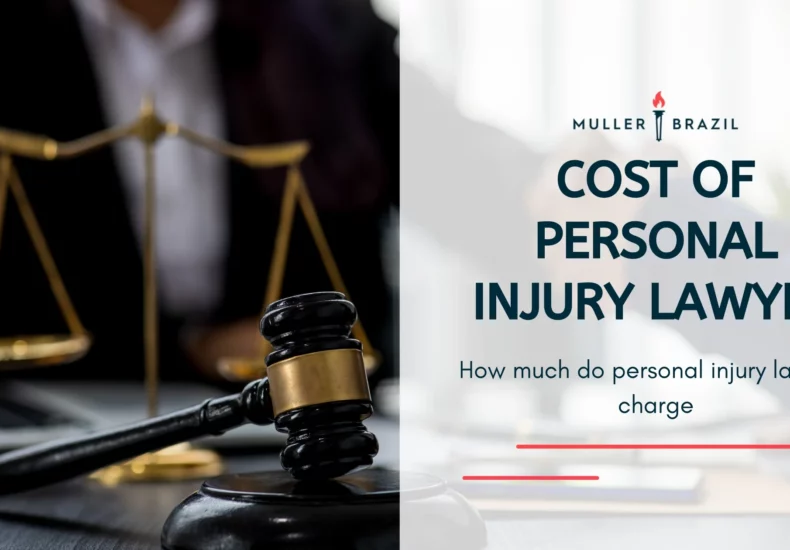
Personal Injury Costs: Unveiling Hidden Expenses and Solutions
Personal injury costs can be overwhelming. They impact your finances and wellbeing.
Personal injuries can arise from car accidents, workplace incidents, or slip and falls. These injuries often lead to unexpected expenses. Medical bills, lost wages, and rehabilitation costs can add up quickly. Understanding the financial burden is crucial for anyone who has suffered an injury.
This knowledge helps you prepare and seek fair compensation. Knowing the costs involved can also guide you in making informed decisions about legal action. Whether you’re dealing with minor injuries or more severe cases, being aware of potential costs is essential. This blog will help you navigate the complexities of personal injury expenses, ensuring you’re better prepared for what lies ahead.

Credit: www.lawbriefpublishing.com
Introduction To Personal Injury Costs
Personal injury costs can be overwhelming. These include medical bills, lost wages, and legal fees. Understanding these expenses helps in managing financial stress effectively.
Personal injury costs can be overwhelming. From medical bills to lost wages, the expenses add up quickly. Understanding these costs is crucial. It helps you plan better. It also ensures you get the compensation you deserve. Personal injury costs vary. They depend on the type of injury and its severity. They also depend on other factors. Let’s explore what personal injury means. Then, we’ll look at common types of injuries.Defining Personal Injury
Personal injury refers to harm caused to your body. It can result from accidents or intentional acts. These injuries affect your physical and mental health. They also impact your daily life. Personal injury law helps victims. It allows them to seek compensation. This compensation covers medical costs, lost wages, and more. Personal injury law is complex. It involves many legal processes.Common Types Of Injuries
Personal injuries come in many forms. Car accidents are a major cause. These accidents lead to severe injuries. Broken bones, whiplash, and head injuries are common. Slip and fall accidents also cause injuries. They can happen anywhere. At home, at work, or in public places. These accidents often result in fractures, sprains, and head injuries. Workplace injuries are another type. They occur on the job. Common examples include back injuries, burns, and cuts. Medical malpractice can also lead to personal injuries. It happens when a healthcare provider is negligent. It results in harm to the patient. Understanding these injuries is important. It helps you know what to expect. It also helps you prepare for the costs involved. “`Medical Expenses
Medical expenses can quickly add up after a personal injury. These costs can be overwhelming and stressful for anyone. Below, we explore two critical aspects of medical expenses: Emergency Room Visits and Ongoing Treatment Costs.
Emergency Room Visits
After an injury, the first stop is often the emergency room. Emergency room visits are necessary to assess and treat severe injuries right away. The costs for this can be quite high.
- Doctor’s fees
- Diagnostic tests
- Medications
- Specialist consultations
Each of these components adds to the total bill. A single visit can range from a few hundred to several thousand dollars. It depends on the severity of the injury and the treatments required.
Ongoing Treatment Costs
For many, the need for medical care does not end with the emergency room. Ongoing treatment costs can continue for weeks, months, or even years. These costs can be broken down into several categories.
- Physical therapy sessions
- Follow-up doctor visits
- Prescription medications
- Special medical equipment
Physical therapy sessions help in recovery but are often expensive. Follow-up visits ensure the injury is healing correctly. Prescription medications can be needed for pain management or to prevent infections. Special medical equipment, like braces or wheelchairs, may also be necessary.
Each of these treatments adds to the overall expense of recovering from an injury. Proper management and planning for these costs are essential for a smooth recovery.
Rehabilitation And Therapy
Rehabilitation and therapy play a critical role in personal injury recovery. They help individuals regain their physical and mental health after an accident. These treatments are essential for a full recovery and can be costly. Understanding the different aspects of rehabilitation and therapy can help you prepare for these expenses.
Physical Therapy
Physical therapy is often necessary after a personal injury. It helps restore movement and strength. A therapist will create a customized plan based on your needs. This plan may include exercises, stretches, and other techniques. The goal is to reduce pain and improve your ability to perform daily activities. Physical therapy sessions can be expensive, so it’s important to budget for them.
Mental Health Support
Personal injuries can also affect your mental health. Many people experience anxiety, depression, or PTSD after an accident. Mental health support is crucial for a complete recovery. Therapists and counselors can provide coping strategies and emotional support. They help you deal with the psychological impact of your injury. Just like physical therapy, mental health support can be costly. Make sure to consider these expenses in your recovery plan.
Lost Wages And Income
Personal injuries can have a significant impact on your financial stability. One of the major costs associated with personal injuries is lost wages and income. These losses can occur both in the short term and long term, affecting your overall financial well-being.
Short-term Losses
Immediately after an injury, you may need to take time off work to recover. This leads to short-term income loss. You may miss days, weeks, or even months of work. During this period, your regular income stops, adding financial stress to your recovery process.
For instance, if you earn $500 per week and miss four weeks of work, you lose $2,000. This calculation is straightforward but highlights the immediate financial impact.
Many employers offer sick leave, but it may not cover the full duration of your recovery. In such cases, the income gap becomes a significant burden. You might also incur additional costs for medical treatment, further straining your finances.
Long-term Impact
The long-term impact of lost wages and income can be more severe. If your injury leads to permanent disability or limits your ability to work, your career and future income are at risk.
Consider the following scenarios:
- Reduced Work Hours: You can only work part-time due to your injury.
- Job Change: You need to switch to a lower-paying job.
- Career End: Your injury forces you to retire early.
Each of these scenarios results in long-term financial loss. For example, if you had planned to work for 20 more years earning $50,000 annually, an early retirement cuts your total earnings significantly.
Another aspect to consider is the potential loss of career growth opportunities. Injuries can limit your ability to take on new roles or promotions, affecting your overall career trajectory.
It’s crucial to account for both short-term and long-term losses when assessing the financial impact of personal injuries. Understanding these costs can help you plan better and seek appropriate compensation.
Legal Fees And Court Costs
Dealing with personal injury costs can be overwhelming. Among these expenses, legal fees and court costs often stand out. Understanding these costs helps in making informed decisions.
Attorney Fees
Attorney fees are a significant part of personal injury costs. Many attorneys work on a contingency fee basis. This means they only get paid if you win the case. The fee is usually a percentage of the settlement. This percentage can range from 25% to 40%. It’s crucial to discuss this with your attorney beforehand. Some attorneys might charge hourly rates. This can be more expensive if the case drags on.
Court Filing Fees
Court filing fees are another cost to consider. These fees are required to start a lawsuit. The amount varies depending on the court and jurisdiction. Typically, filing fees range from $50 to $400. This fee covers the cost of processing your case. If you cannot afford these fees, you might qualify for a fee waiver. Filing fees are just one part of the court costs. Other expenses may include service fees for delivering legal documents.

Credit: www.irvinebookkeeping.com
Property Damage
Property damage is a significant aspect of personal injury costs. It includes the repair or replacement of damaged possessions. This section will focus on the costs related to vehicle repairs and personal belongings.
Vehicle Repairs
Vehicle repairs form a large part of property damage costs. After an accident, your car may need extensive repairs. This can include:
- Bodywork
- Engine repair
- Paint jobs
- Replacing parts
The cost of repairs depends on the damage extent. Minor dents may be cheap to fix. Major damages can be expensive. Insurance may cover some of these costs. But, you may still face out-of-pocket expenses.
Personal Belongings
Besides your vehicle, personal belongings can also be damaged. Items like phones, laptops, and clothing can incur costs. Here are some common items:
- Electronics
- Jewelry
- Clothing
- Sports equipment
Replacing these items can be costly. Documenting all damaged items is essential. This helps in filing insurance claims. Keeping receipts can speed up the process.
In some cases, you may need to prove the value of your belongings. Taking photos before and after the accident can help. This evidence supports your claim and ensures you get fair compensation.
Hidden Costs
Personal injury costs often go beyond medical bills and lost wages. Hidden costs can significantly impact a person’s life. These hidden costs are less obvious but just as burdensome. Understanding these hidden costs is essential for anyone facing a personal injury.
Emotional Distress
Emotional distress is a common hidden cost of personal injury. Injuries can cause anxiety and depression. This emotional toll can affect daily life and relationships. Therapy and counseling may be needed. These services are often expensive. Emotional distress can also lead to sleep problems and stress.
Lifestyle Changes
Lifestyle changes are another hidden cost of personal injury. Injuries can limit physical activities. This may lead to a loss of hobbies and social interactions. Injuries may also require home modifications. These modifications can be costly. Changes in lifestyle can impact overall happiness and well-being.
Solutions And Compensation
Personal injury can lead to significant costs. These include medical bills, lost wages, and emotional distress. Finding solutions and seeking compensation is vital. Understanding insurance claims and legal settlements can help.
Insurance Claims
Insurance is the first line of defense. It can cover medical expenses and other costs. Here are some steps to take:
- Contact your insurance company immediately after an injury.
- Provide all necessary documentation.
- Keep track of your medical treatments and expenses.
Insurance claims can be complex. Having a clear record helps. Sometimes, insurance companies may not pay the full amount. In such cases, legal action might be necessary.
Legal Settlements
Legal settlements offer another way to get compensation. This can include pain and suffering, lost wages, and future medical costs. Here are the steps involved:
- Hire an experienced personal injury lawyer.
- Gather evidence, such as medical records and witness statements.
- Negotiate with the other party’s insurance company.
- Consider going to court if a fair settlement is not reached.
A lawyer can help you navigate the legal process. They can increase your chances of getting fair compensation. Legal settlements can provide more comprehensive coverage.
Preventative Measures
Personal injury costs can be overwhelming. Taking preventative measures helps reduce these costs. Simple steps make a big difference. Let’s explore some effective strategies to prevent injuries.
Safety Precautions
Implement safety measures at home and work. Use non-slip mats in bathrooms and kitchens. Install grab bars in showers and near toilets. Ensure good lighting in all areas. Remove clutter from walkways to prevent trips and falls.
At work, follow safety protocols. Wear protective gear. Attend safety training sessions. Report hazards promptly. Safety precautions minimize the risk of injury.
Health And Wellness
Maintain a healthy lifestyle. Eat a balanced diet. Exercise regularly to keep muscles strong. Stay hydrated. Get enough sleep to stay alert and focused.
Visit your doctor for regular check-ups. Address health issues early. Keep vaccinations up to date. Health and wellness practices help prevent injuries and reduce personal injury costs.

Credit: www.schneiderwallace.com
Frequently Asked Questions
What Are Common Personal Injury Costs?
Personal injury costs often include medical bills, lost wages, and rehabilitation expenses. They may also cover property damage and legal fees. These costs can quickly add up, causing financial strain on the injured party.
How Are Personal Injury Costs Calculated?
Personal injury costs are calculated by assessing medical bills, lost income, and pain and suffering. Future expenses and ongoing care needs are also considered. Each case is unique, requiring detailed evaluation.
Can Insurance Cover Personal Injury Costs?
Yes, insurance can cover personal injury costs depending on the policy. It typically includes medical expenses, lost wages, and sometimes pain and suffering. It’s important to review your policy details.
What Factors Influence Personal Injury Costs?
Several factors influence personal injury costs, including the severity of the injury, medical treatment required, and recovery time. Other factors include lost income and the impact on daily life.
Conclusion
Understanding personal injury costs is crucial for everyone. Medical bills can pile up. Lost wages create financial strain. Legal fees add to the burden. Awareness helps manage these costs better. Take proactive steps to secure your future. Seek guidance from professionals.
Stay informed and prepared. Knowledge empowers you to handle unexpected events. Protect yourself and your loved ones. Stay safe and vigilant.

Leave a Reply